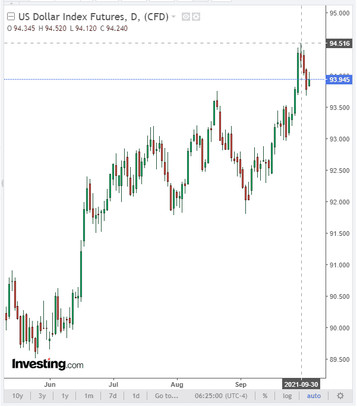At the end of the meeting, which ended on Tuesday, the Reserve Bank of Australia left the key interest rate at a record low level of 0.1%, where it has been since the end of 2020.
RBA Governor Philip Lowe said it will take some time for wages to rise and inflation accelerate, which could create conditions for rate hikes.
"According to the main scenario, such conditions will develop no earlier than 2024. Achieving such conditions will require strengthening the labor market to such an extent that it can generate significantly stronger wage growth than it is now", said the head of the central bank.
The Australian dollar reacted with a decline to this decision by the RBA. Now market participants will pay attention to the results of the meeting of the other largest world and Asia-Pacific region central bank. On Wednesday, the RB of New Zealand will hold its next meeting, and at 01:00 (GMT) will publish its decision on the interest rate. And here there may be surprises. If the decision of the RBA to keep the current monetary policy was expected by market participants, then the RBNZ may tighten its monetary policy already at this meeting.
In early August, representatives of the RBNZ management proposed tightening mortgage lending standards from October 1. The bank's management will hold "consultations on restrictions regarding the ratio of the size of debt obligations and income, the minimum level of interest rates", since “the previous restrictions did not lead to a significant reduction in risky lending”. The goal of these measures is to reduce the share of the most risky new home loans to 10% from the current level of 20%. This news contributed to a rather sharp strengthening of the New Zealand dollar, until the moment when in mid-August, the country's health authorities announced the detection of the first case of coronavirus infection since February and hinted at the need to introduce a lockdown. Their statement notes that "early tough response" is the "best tool" for stopping the spread of the coronavirus.
At its August 18 meeting, the Reserve Bank of New Zealand left its key interest rate unchanged at a record low of 0.25%. Prior to the detection of the delta strain of coronavirus in New Zealand, it was widely expected that the RBNZ at this meeting would raise the official rate by 25 basis points and announce the continuation of the phased rate hike process. The central bank's forecasts did indeed imply an increase in the rate to 0.6% by December of this year and to 1.6% by December next year.
And now expectations of an increase in the RBNZ rate have revived again. It is assumed that tomorrow the RBNZ will raise the interest rate by 0.25% to 0.5% and thus become the first of the world's largest central banks to take such a step.
Indeed, rising government spending and lower interest rates in response to the pandemic have overheated the New Zealand economy, pushing inflation above the RBNZ target. At the same time, the rate of increase in the incidence of coronavirus in New Zealand slowed down again, which, in turn, supported expectations of an increase in RBNZ interest rates.
However, the RBNZ management may again postpone its decision to tighten monetary policy.
Despite the fact that the country's GDP in the 2nd quarter of 2021 grew by +2.8% (+17.4% in annual terms), which is higher than the forecast +1.3% and previous values +1.6%, - 1.0%, the latest macroeconomic data falls short of the forecasted values and does not meet expectations. Thus, the NZIER business confidence index for the 3rd quarter of 2021, published last Monday, decreased by -11% after growing by +7% in the 2nd quarter. The capacity utilization rate for Q3 2021 increased by 96.1% after growing by 94.9% in the previous period. These and other data released earlier indicate that the economic recovery in New Zealand has slowed, including due to rising energy prices. Thus, the commodity price index, according to the ANZ report presented today, rose 1.5% in September following oil and gas prices.
The RBNZ, like other major central banks, faces the daunting challenge of preempting accelerating inflation but not hurting the economic recovery. And this keeps the intrigue around the actions of the RBNZ. If tomorrow the bank's management decides to postpone the expected increase in interest rates, then the NZD quotes may decline sharply.
Conversely, if the RBNZ raises the interest rate tomorrow, then the strengthening of the NZD will gain momentum for the near medium term.
As for the US dollar, it is strengthening again today, and the DXY dollar index is growing again after declining in the previous 3 days. As of this writing, DXY futures are traded near 93.95, 27 pips above yesterday's local low.

Demand for the dollar is rising again amid alarming news from China, where developer China Evergrande Group remains on the brink of bankruptcy, and yesterday, another major Chinese developer, Fantasia Group Holdings, announced that it could not pay off certain dollar bonds. Trading in Fantasia shares has been suspended.
At the same time, the recent rise in US government bond yields put pressure on the tech sector, causing the Nasdaq Composite to lose more than 2% on Monday. Yesterday, active sales of shares in some of the largest technology companies led to an overall decline in equity markets.
The demand for the US dollar also remains amid investors' expectations about the tightening of the US Federal Reserve's monetary policy. According to forecasts, the Fed plans to announce a cutback in its bond buyback program at its next meeting, which is scheduled for November 3. Reduced liquidity in the market will lead to an increase in demand for the US dollar, and investors have already begun to build on the possibility of tightening the Fed's monetary policy in prices.
Today at 14:00 (GMT) the ISM PMI in the US services sector will be published. Service sector data have less impact on a country's GDP than manufacturing sector data. Activity is expected to slow down in September compared to August due to consumer concerns about the delta strain of the coronavirus. In July this indicator came out with a value of 64.1, and in August 61.7. The forecast for September is 60.0, which is likely to positively affect the USD in general, despite a slight relative decline in the indicator. A result above 50 is seen as positive for the USD. However, a deeper relative decline in the index could negatively affect the dollar in the short term.





